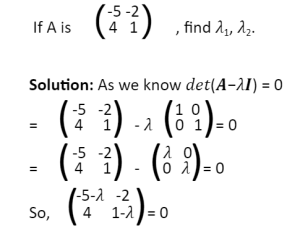Eigenvalues and Eigenvectors are used in linear algebra in mathematics, but in physics, these are widely used for vibration analysis, simple harmonic oscillators, quantum mechanics, matrix diagonalisation, and atomic orbitals. In particular, molecular physics uses Eigenvalues as ionisation potentials.
The physical system has a wave function. Schrodinger’s equation is the solution to obtain the specific Eigenvalues of a physical system. Therefore, as physics seems to be everywhere in the environment, we have made these Eigenvalues and Eigenvectors solved problems notes for you. We will try to explain what Eigenvalues and Eigenvectors are. We even used simple techniques for Eigenvalues and Eigenvectors Solved Problems. Let’s explore.
What are Eigenvalues and Eigenvectors?
Briefly and simplified, the Eigenvalues and Eigenvectors are the eigenfunctions that often play a role in mechanics. The Eigenvector represents the principal axes, which can be decomposed in a stress tensor. The Eigenvalues define diagonal while Eigenvectors are taken as a basis. In general terms, Eigenvalues can be defined as a characteristic scalar value denoted by 𝜆. At the same time, an Eigenvector is a vector affected by a scalar factor, i.e. Eigenvalue when applied. Eigenvalues transform the direction of an Eigenvector.
The equation can be represented as:
𝑨𝒙=𝜆𝒙
Where,
A = Linear transformation from a vector space
𝜆 = Eigenvalue of A
𝒙 = Vector in vector space V
Before discussing Eigenvalues And Eigenvectors solved problems, let’s discuss the applications of Eigenvalues And Eigenvectors.
Applications of Eigenvalues and Eigenvectors
The equations of Eigenvalues and Eigenvectors are applied when solving problems related to light waves and microwaves that transport through the system. Sometimes Eigenvectors can measure the centrality of vertices. Eigenvectors are the means to study large data sets, even in principal component analysis. The Eigenvalues of the correlation matrix determine the practical significance.
Now, look for the method to find Eigenvalues in this Eigenvalues and Eigenvectors solved problems notes.
How to find Eigenvalues?
Follow these steps for an easy understanding of Eigenvalues and Eigenvectors solved problems.
- Before we start the approach, remember the question will have a square matrix 𝑛 × 𝑛.
- Assume that 𝑨 is an 𝑛 × 𝑛 matrix. Let’s take 𝜆 as an Eigenvalue of A.
- An Eigenvector 𝒙 will be a real non-zero vector pointing in the direction where Eigenvalues stretch it.
- Remember that the linear transformation is 𝒚 = 𝑨𝒙.
So to find Eigenvalues, we need to follow a linear algebra approach.
As the matrix equation is 𝑨𝒙 = 𝜆𝒙
Then, (𝑨−𝜆𝑰)𝒙 = 𝟎
Where 𝑰 is the 𝑛 × 𝑛 identity matrix, but the above equation should be taken into consideration only if the determinant value equals zero.
Hence, the matrix (𝑨−𝜆𝑰) is singular ⟹ 𝑑𝑒𝑡(𝑨−𝜆𝑰) = 0.
When (𝑨−𝜆𝑰) is expanded, 𝑝𝜆 = 𝑑𝑒𝑡(𝑨−𝜆𝑰) would be the polynomial of degree 𝑛.
Eigenvalues And Eigenvectors Solved Problems
Here are some Eigenvalues And Eigenvectors solved problems.
1 1
Problem 1: If A is(4 1)𝜆1 = 3, 𝜆2 = -1
→
If (𝑨−𝜆𝑰) v = 0
→ →
Then, find v1 and v2.
Solution:
1 1 1 0 x1 0 1 1 1 0 x1 0
(4 1) -3 (0 1) (x2)=(0) ,
(4 1)-(-1) (0 1) (x2)=(0)
1 -3 1 x1 0 1 +1 1 x1 0
(4 1 -3)(x2)=(0) , ( )( ) ( )
4 1 +1 x2 = 0
-2 1 x1 0 2 1 x1 0
( 4 -2)(x2)=(0) , ( 4 2)(x2)=(0)
-2 x1 +x2 = 0 2 x1 +x2 = 0
2×1 = x2 2x1 = x2
x1 = 1 x1 = -1
一 一 一 一
x2 2 x2 2
→ 1 → 1
Therefore, v1 = (2), v2 =(-2)
1 2
Problem 2: If A is(3 -4), find 𝜆1, 𝜆2.
Solution: As we know 𝑑𝑒𝑡(𝑨−𝜆𝑰) =0
1-𝜆 2
So, ( 3 -4-𝜆)
= (1-𝜆)(-4-𝜆)-2-3
= -4-𝜆+ 4𝜆+𝜆2-6
= 𝜆2+3𝜆-10
= (𝜆-2)(𝜆+5) = 0
Hence, 𝜆1 = 2, 𝜆2 = -5
1 4
Problem 3: If A is(3 2)𝜆 = 5, -2
→
If (𝑨−𝜆𝑰) v = 0
→ →
Then, find v1, v2.
Solution:
1 -𝜆 4 x1 1- 𝜆 4 x1
(3 2 -𝜆)(x2) = 0 , (3 2 – 𝜆 ) (x2)= 0
-4 4 x1 3 4 x1
(3 2 -5)(x2) = 0 , (3 4 ) (x2)= 0
1 -4
Therefore, v1 = (1), v2 =(3 )
Conclusion
Eigenvalues and Eigenvectors are used in linear algebra in mathematics, but in physics, these are widely used for vibration analysis, simple harmonic oscillators, quantum mechanics, matrix diagonalisation, and atomic orbitals. In particular, molecular physics uses Eigenvalues as ionisation potentials.
Eigenvalues and Eigenvectors are one of the interesting topics of physics and chemistry both. In quantum mechanics, Eigenvalues And Eigenvectors solved problems that can even help determine the orbitals of atoms and molecules through Hartree-Fock theory. These Eigenvalues and Eigenvectors solved problems notes of Eigenvalues and Eigenvectors can help students in the problems related to light waves and microwaves that transport through the system.
 Profile
Profile Settings
Settings Refer your friends
Refer your friends Sign out
Sign out







